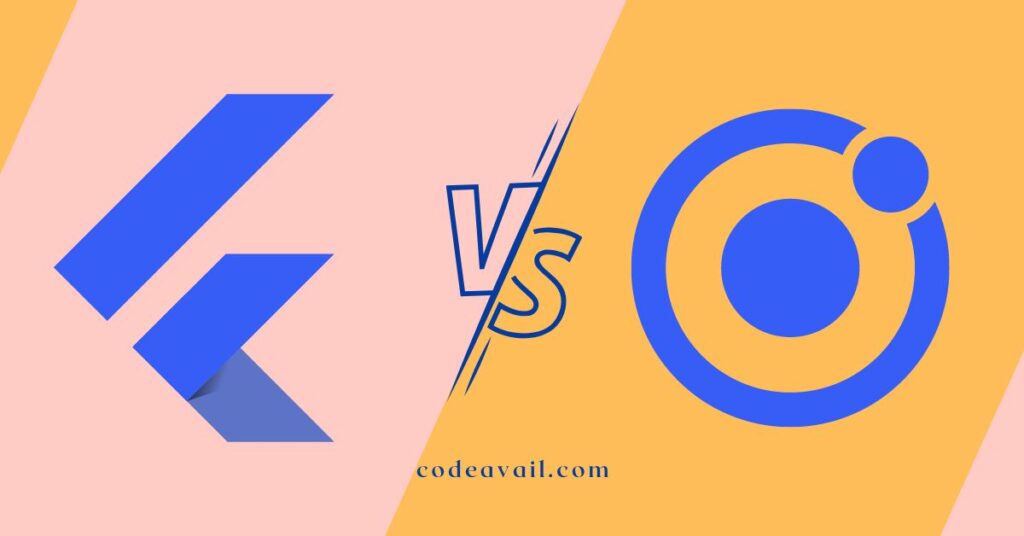Flutter and Ionic are both frameworks for developing mobile applications. However, they have a few differences in features and syntax, so it can be difficult to choose which one is right for you. Flutter is a new declarative, reactive framework for building Android and iOS apps. Flutter works with existing code, is used with existing tools, and plugins with existing libraries. Ionic is a front-end mobile app development framework focused on speed and ease of use.
So if you’re looking to develop an app for the two most popular mobile platforms, it’s worth taking into consideration the types of tools each has to offer. This article will tell you what is the difference between Flutter vs Ionic, and which framework is better for your project.
What Is Flutter Framework?
Table of Contents
Flutter is a new cross-platform mobile development framework from Google. It is a Google-backed mobile app SDK that allows developers to create native applications for iOS and Android with a single codebase. Flutter is known for its fast development cycle, expressive UI, and ease of use. Flutter is still in beta, but it’s already being used by some big names, including Alibaba and Google itself.
What Is Ionic Framework?
Ionic is a popular framework for building mobile apps with HTML, CSS, and JavaScript language. It has been around since 2012 and has been used to build many popular apps. Ionic is open source and has a large community of developers who contribute to its development. Ionic is a great choice for building hybrid mobile apps. Hybrid apps are those that are built using web technologies but run natively on mobile devices.
Ionic allows you to use your existing web development skills to build apps that will run on both iOS and Android devices. Ionic is easy to learn and use. It has a well-documented API and a large number of tutorials and resources available online. If you’re looking for a framework to help you build cross-platform mobile apps, Ionic is a great option.
So, which one should you use for your next project? Let’s take a closer look at each framework to see how they compare.
Flutter vs Ionic: Comparing the Two Frameworks
When it comes to choosing a cross-platform mobile development framework, there are two popular options: Flutter and Ionic. Both frameworks have their own pros and cons, so it can be difficult to decide which one to use for your project.
To help you make a decision, let’s take a look at how Flutter and Ionic compare in terms of key features.
Performance
One of the most important considerations for any mobile app is performance. Flutter has the advantage here, as it uses Dart – a language that is compiled ahead of time (AOT) – which results in apps that are fast and responsive. Ionic, on the other hand, uses JavaScript, which is not compiled ahead of time. This can lead to apps that are slower and less responsive.
Development Speed
Another important consideration is development speed. Ionic has the advantage here, as it is easier to develop apps quickly with its pre-built components and tools. Flutter is also easy to use, but it doesn’t have as many pre-built components, so it can take slightly longer to develop apps with it.
User Experience
When it comes to user experience, Flutter has the upper hand.
Flutter vs Ionic: Comparison Table
Here’s a handy comparison graphic that breaks down some of the most important differences between Flutter vs Ionic.
| Flutter | Ionic | |
| Language | Dart | HTML, CSS, JavaScript |
| UI elements | Proprietary Widgets | Standards-based Web Components |
| Runtime | Custom graphics engine | Web browser |
| Mobile performance | Excellent | Very good |
| Offline access | Yes | Yes |
| Deployment options | Mobile, Desktop, Web | Mobile, Desktop, Web, PWA |
| Native API access | Native plugin library, using Flutter native packages | Native plugin library, using Cordova and Capacitor |
Uses of Flutter
Primary uses of flutter include:
- MVP Mobile Applications
- Applications based on the Material Design Language
- Functionality native to the operating system that apps may access
- Simple logic underlies even the most sophisticated operating system plugins.
- Applications that use the Skia rendering engine are fast and efficient.
- Extremely adaptable user interface and cutting-edge tools
- Massive integrated, reactive programmes with a lot of data
Uses of Ionic
- Hybrid mobile app development.
- Native wrapper
- MVC mobile apps
- Cross-platform mobile application development.
- Hardware functionality is allowed for the app.
- High-performance UX/UI applications
Flutter vs Ionic: Which One Should You Choose to Develop an app?
There are many factors to consider when choosing a platform for developing a mobile app. Flutter and Ionic are two popular options. Flutter is Google’s mobile UI framework that allows you to create native apps for Android and iOS. It is free and open source. Ionic is a framework for creating hybrid apps. It is also free and open source. Both platforms have their pros and cons. Flutter is faster and easier to learn, but it doesn’t have as many plugins and libraries as Ionic. Ionic is more flexible, but it can be slower and more difficult to learn. Ultimately, the best choice depends on your specific needs and preferences.
Flutter vs Ionic: Pros and Cons of Both Framework
To help you make a decision, we’ve compiled a list of the pros and cons of flutter and Ionic. Take a look and see for yourself if flutter is right for you or ionic.
Pros and Cons of Flutter
Pros:
- Flutter is fast. Really fast. It promises to help you create high-quality apps with smooth animations in record time.
- It’s easy to get started with flutter. All you need is a basic understanding of Dart, and you’re good to go.
- Flutter is cross-platform. This means that you can write one codebase for your app and have it work on both iOS and Android devices.
- There is a growing community of flutter developers out there who are willing to help answer your questions and provide support.
Cons:
- Flutter can be difficult to learn if you’re coming from a background in traditional web development. It’s a different way of thinking, and it takes some time.
Pros and Cons of Flutter
Pros:
- Ionic offers a wide range of features, making it suitable for creating complex apps.
- It integrates well with other frameworks and libraries, allowing you to create hybrid apps.
- Ionic is open source, so it’s free to use.
- The community support for Ionic is strong, so you can find help and resources when needed.
Cons:
- Ionic can be slow at times, particularly when rendering large amounts of data.
- The documentation for Ionic is sometimes lacking, which can make it difficult to learn.
- Some features are still in development and may not be stable enough for production use.
Conclusion
In conclusion, both Flutter and Ionic are great frameworks for mobile app development. However, there are some key differences between the two. Flutter is best suited for apps with a lot of animation and graphics, while Ionic is better for apps that need to be lightweight and fast. Ultimately, the choice of framework depends on the specific requirements of your project.


